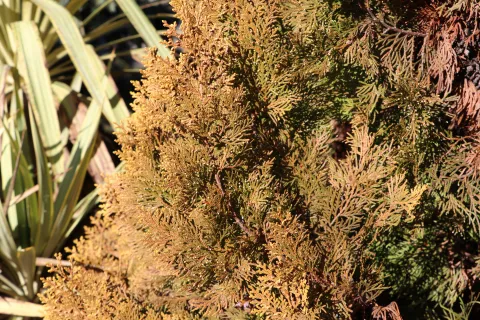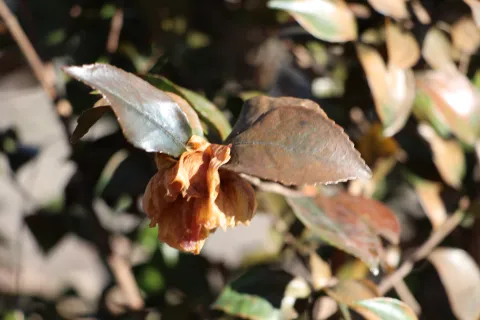Handling the Holiday Freeze in your Lawn and Landscape

Cold damage to cryptomeria
Photo Credit: Celeste Scott, UT Extension
The recent holidays blew in with a winter storm that will not soon be forgotten. Here in Tennessee, we missed much of the snowfall that wreaked havoc across the Midwest and Northeast. However, wind and cold temperatures packed a punch for our power grids and landscapes over the Christmas weekend. Now we find ourselves starting 2023 with many questions about the extent of damage and next steps for our lawns and landscapes. Before we get to action steps, let’s recap our recent freeze event.
The weather event presented itself as a 39°F drop in Maynardville, from 50°F at 2 pm Dec. 22nd to 5°F at 9 am on Dec. 23rd. This rapid drop was accompanied by gusty winds and sustained below 15°F for at least 32 hours. Shockingly, temperatures didn’t rise above 32°F for more than 80 hours. Freeze damage in plants is largely the result of ice formation within the plant that punctures cell walls, and those temperatures across the state were certainly severe enough for this to occur. Additionally, the rapid drop meant plants were less able to implement internal defense measures to tolerate low temperature stress. Wind also contributed to desiccation (drying) that can injure plants.
Most warm-season turfgrasses, such as zoysiagrass and bermudagrass, had already transitioned into winter dormancy before this event, so signs of damage won’t appear until warmer weather in the spring. Injury on cool-season turfgrasses is quite visible with leaves that are usually green having brown, necrotic, tissue. Many conifers are now showing a golden or brown coloration, but we will not know the extent of the injury for a few more months. Low temperatures might have been especially harmful to zone 7 or 8 landscape plants, such as Acuba, Camellia, Distylium, Yaupon holly, Indian Hawthorn, Loropetalum, fig, and more. Close inspection of boxwood and azalea may reveal the bark is split, cracked, or peeling from the trunk. Because this disrupts the plant’s ability to move water from the roots to the leaves, plants with this type of damage are not expected to recover quickly, if at all. Spring may reveal some woody species, such as crape myrtle, killed to the ground or warm-season grasses, tender perennials, and even “borderline” woody plants killed outright. The rapid change in temperature, magnitude of drop, and duration of lethal temperature exposure may end up being a triple whammy. Only time will tell the full extent of this winter weather event.
April and May seem far away, and you are probably wondering what you can do now. First, be patient! The best action right now may actually be to do nothing. For herbaceous (non-woody) plants, those that are borderline for our area (hardy banana, calla, canna, and more) as well as plants that are often evergreen (hardy ferns, Heuchera, Lenten rose and more) may have been killed to the ground. Leaving that now-dead aboveground tissue may provide a bit of insulation in the coming weeks for plants that survived. So, don’t do extensive cleanup or mowing. You don’t want to get carried away with pruning woody plants either. Waiting until plants leaf out (or don’t) in the spring will give you the best indication of what to prune. Be patient; plants like bigleaf hydrangea may not resume growth until as late as Mother’s Day, and flower buds except those that develop on new growth were likely damaged by the cold temperatures. Plus, pruning now could expose still-living tissue to further cold damage in the coming weeks. If you are concerned about whether a plant is still alive, you can always perform a “scratch test”. This can be done by gently removing (scratching off) a small section of the bark on small stems/twigs to expose the cambium. Green tissue indicates a living stem. If the tissue is brown, then it is dead. Keep in mind that different plant tissues (leaves, buds, stems) on the same plant can vary in cold hardiness with roots being most sensitive to low temperatures. So, the impacts may differ due to plant tissue type, age, and health as well as location due to drainage, snow cover, air flow, and microclimates. Plants in containers on decks and patios will have more damage that those same plants in the ground because the roots are less insulated from the cold Another practice that isn’t helpful right now is fertilization. Whether dead or dormant, plants are not taking up many nutrients right now.
In the short term, make sure to manage any drainage issues to prevent waterlogging on lawns and landscapes that are already stressed. Likewise, monitor moisture levels to ensure that landscape plants, especially evergreens, don’t dry out. For long-lived plants, the effects of such stress events may be variable and take a while to become evident. It is important to understand this and further reduce other stressors in the coming months as much as possible (manage pests, irrigate if needed, prune carefully). As the effects become clear, we’ll either be relieved to see the return of old plant favorites or we’ll get to select some exciting new plants for our lawns and landscapes. Either way, we invite you, as always, to connect with your local UT Extension office with questions and check out UThort.com for lawn, landscape, and garden resources.
Authors: Natalie Bumgarner, Jim Brosnan, Amy Fulcher, Lucas Holman, Lee Rumble, Taylor Reeder, Celeste Scott, and Justin Stefanski
Weather data source: https://www.wunderground.com/history/daily/us/tn/louisville/KTYS/date/2…
- Log in to post comments
